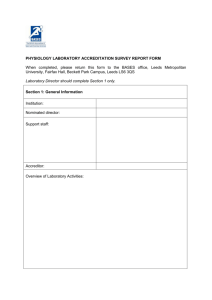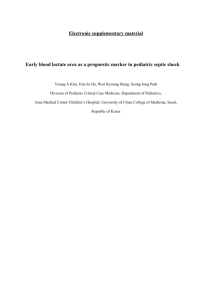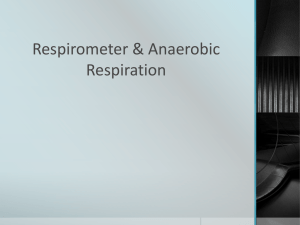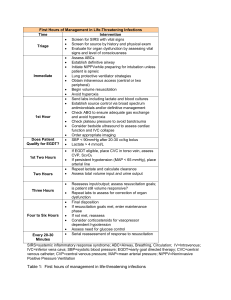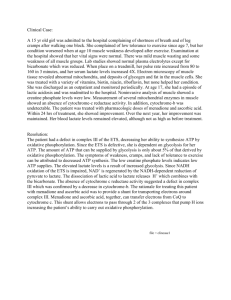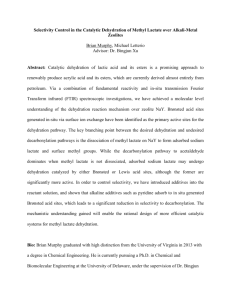Title Evaluation of the lactate pro portable blood lactate analyser
advertisement
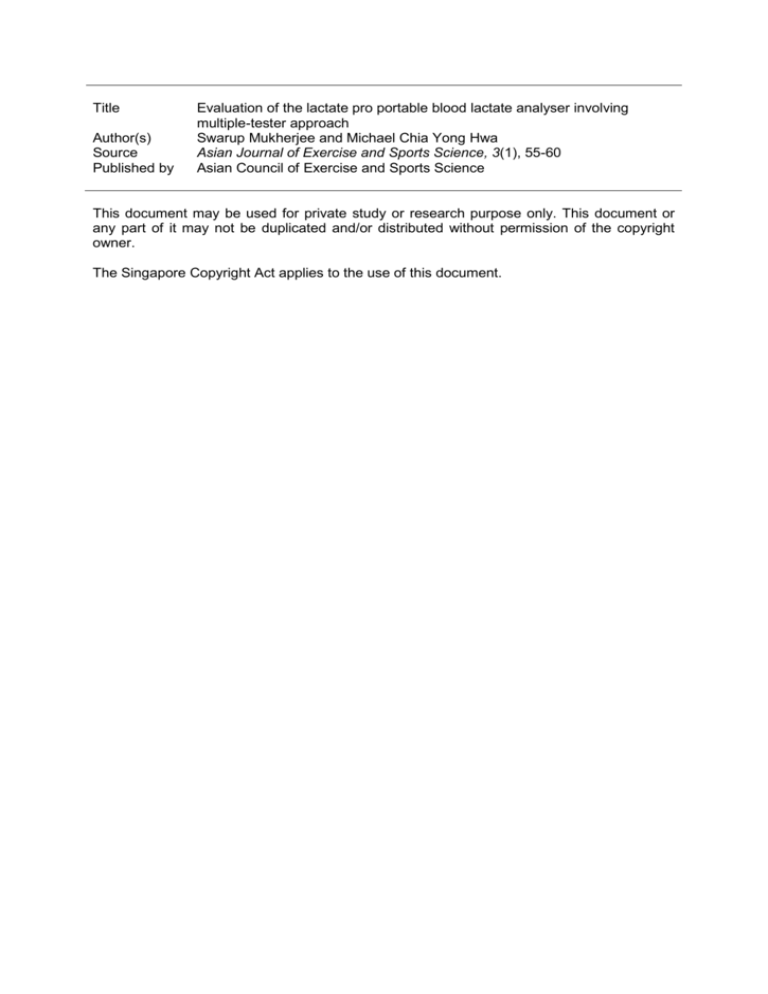
Title Author(s) Source Published by Evaluation of the lactate pro portable blood lactate analyser involving multiple-tester approach Swarup Mukherjee and Michael Chia Yong Hwa Asian Journal of Exercise and Sports Science, 3(1), 55-60 Asian Council of Exercise and Sports Science This document may be used for private study or research purpose only. This document or any part of it may not be duplicated and/or distributed without permission of the copyright owner. The Singapore Copyright Act applies to the use of this document. Asian Journal of Exercise & Spores Science 2006 Vo1.3 (No.1) Original Article EVALUATION OF THE LACTATE PRO PORTABLE BLOOD LACTATE ANALYSER INVOLVING MULTIPLE~TESTERApPROACH Swarup Mukherjee & Michael Chia Yong Hwa Physical Education and Sport Science Academic Group, National Institute of Education, Nan yang Technological University An investigation was done to determine the acceptability of the Lactate Pro LT -1710( blood lactate analyser while using a multiple-tester approach by assessing its accuracy, consistency, reliability and validity by comparing it to the YSI 2300 STAT PlusTM as the reference blood lactate analyser. The study was conducted in three phases separated seven days apart. The participants (n=9) completed the Bruce protocol on the motorised treadmill in the phase 1 and 2 and an all-out 30 s sprint on the non-motorised treadmill in the third phase. Pre and post-exercise capillary blood samples were collected from the finger-tip of the participants. Blood lactate data for all the three test days were pooled to determine the overall comparative agreement between the two analysers over a range of blood lactate values 0-16.2 mmol.L-1). A significant and high correlation was obtained for the combined pooled data (r=0.994, p<0.05). The ratio limits of agreement for pooled pre-exercise, pooled post-exercise and combined data were 0040­ 0.91, 0.61-0.84 and 0.53-0.90 respectively indicating the consistency of the blood lactate analysis by the Lactate Pro 1710(r) over a range (1-16.2 mmol.L-1) of blood lactate values. This study found the Lactate Pro 1710 blood lactate analyser to be acceptably accurate, consistent, reliable and valid to be used under varied exercise and training situations, especially when multiple testers are likely to be involved in the analysis. Asian Journal of Exercise & SPOTts Science, 2006, 3(1): 55-60 Keywords: Lactate analysis, portable, acceptability, consistency, multiple-tester, ratio limits of agreement Introduction Blood lactate analysis is routinely performed by sports and exercise scientists to obtain information regarding physiological and metabolic strain experienced by the athletes in response to different exercise protocols involving different work intensities. This measure has been used for prediction of exercise performance and the control of training intensity (Billat, 1996), for determination of the anaerobic threshold (Aunola and Rusko, 1992; Londeree, 1997; Marcell, Hawkins, Tarpenning, Hyslop, and Wiswell, 2003; Pfitzinger and Freedson, 1998) and for the determination of the degree of anaerobic contribution to the activity being performed (Bangsbo, 1998). In addition, blood lactate measurements have been used for the evaluation of the stability of blood lactate-HR relationship in competitive athletes (Foster, Fitzgerald, and Spatz, 1999), for the determination of the effects of different recovery interventions on lactate removal (Ahmaidi, Granier, Taoutaou, Mercier, Dubouchaud, and Prefaut, 1996; Mondero and Donne, 2000), to determine blood lactate concentrations during intermittent all-out Corresponding Aurhor Swarup MUKHERJEE Physical Educarion and Sparr Science Academic Group Narional Insrirure of Educarion, Nanyang Technological Universiry 1 Nanyang Walk, Singapore 637616 Tel: 65-67922204; 96214821 E-maIl: swarup@mail.nie.edu.sg exercise (Mognoni, Redolfi, Colombini, and Sirtori, 1997) and for the examination of the effect of test interruptions on blood lactate (Beneke, Huder, Von Duvillard, Sellens, and Lithauser, 2003). Further, plasma lactate estimations have also been conducted during different exercise intensities (Hildebrand, Lormes, Emmert, Liu, Lehmann, and Steinacker, 2000; Oosthuyse and Carter, 1999). With such wide applications of exercise lactate concentrations, a range of analysers have been developed and designed for lactate estimation. Exercise testing of sports persons in both field and laboratory settings involving blood lactate estimation requires analysers that are accurate, reliable, consistent and easy to operate. It can be reasonably proposed that field­ based assessments of fitness have greater degree of acceptability among coaches and athletes. lienee, lactate assessment in field settings require analysers that are light weight, portable, self powered, simple to operate, proVide quick results and are acceptably accurate, consistent and reliable over a range of training intensities. The availability of an analyser in the field has an additional advantage of minimising the delay between sample collection and its assay. This provides a better picture of the measure being determined and provides the scientist and the coach with immediate feedback and useful information regarding the efficacy of the training program. Among the portable blood lactate analysers, the Accusport( (Boehringer-Mannheim) and the Lactate Pro 55 Asian Journal of Exercise & Sports Science 2006 VoU (No.l) LT-1710( (Arkray Factory Inc, KDK Corporation, Shiga, Japan) are the ones commonly used by coaches and scientists. In fact, Accusport has been termed as the most direct competitor of the Lactate Pro analyser (Pyne, Boston, Martin, and Logan, 2000). While the Accusport( has been widely studied for the evaluation of its reliability, validity and suitability (Bishop, 2001; Fell, Rayfield, Gulbin, and Gaffney, 1998; McNaughton, Thompson, Philips, Backx, and Crickmore, 2002; Medbo, Mamen, Olsen, and Evertsen, 2000; Pinnington & Dawson, 2001), fewer studies have focussed on the Lactate Pro analyser (Medbo et aI., 2000; Pyne et aI., 2000). Moreover, no study to our knowledge has attempted to evaluate the practical acceptability of the Lactate Pro 1710( using a multiple tester approach. While the studies evaluating the Accusport( blood lactate analyser have found it to be of practical use, they do raise some concerns regarding its reliability and accuracy over wide range of lactate concentrations and over multiple trials (Bishop, 2001; Pinnington and Dawson, 2001). There is also a lack of consensus about its validity when compared to reference lactate analysers (Bishop, 2001; Pinnington and Dawson, 2001). Further, Ed McNeely (2000) of Rowing Canada Sport Medicine and Science Committee found that the Accusport( proved to be unreliable when compared to the YSI 1500 lactate analyser (Yellow Springs Inc, Ohio, USA). The researcher suggests that the volume of blood applied to the strip is crucial to the accuracy of measurement and the Accusport( analyser has no means of controlling the blood sample volume applied to the test strip. This factor apparently created a large amount of between-tester error. The aim of the present study was to evaluate the suitability and the acceptability of the Lactate Pro LT -171 O® for the estimation of blood lactate using capillary blood samples, analysing its accuracy and consistency by comparing it to the YSI 2300 STAT Plus™ blood lactate analyser as the reference analyser. Since a portable lactate analyser is expected to be used in the field by different coaches, trainers and athletes, we also examined if the between­ tester error has a consequence on the acceptability of the Lactate Pro LT -171 O®, by allowing the different testers (n=9) to perform the analysis on the Lactate Pro LT-1710® analyser while the assay on the YSI 2300 STAT PlusTM was performed by the same technician throughout the study. Method Participants Seven male and two female physical education students volunteered for the study after being informed verbally and in writing about the nature of the study and the possible risks involved. All the participants were non-smokers and active sportspersons being regularly involved in organised sporting activities. The physical characteristics of the participants were (Mean:t: SD) age, 25.0:t: 2.9 yrs; stature, l.70:t:0.08 m and body mass of 66.9:t: 11,4 kg. 56 Experimental design The study was conducted in three phases separated seven days apart. The phase 1 and 2 comprised on performing the Bruce protocol on the motorised treadmill and the phase 3 involved performing an all-out 30s sprint on the non-motorised treadmill. All the participants underwent at least two familiarization trials on both the protocols prior to performing the actual exercise sessions. General methodological approach All the participants were advised to avoid consumption of heavy meals and caffeinated drinks at least three hours prior to the test session and to refrain from consuming any food or drink, except water, one hour prior to the test. The same was verbally confirmed on arrival of the participants in the laboratory. The laboratory environment was air-conditioned with the temperature between 21-24 0 C and relative humidity between 60-65%. On arrival at the laboratory, the participants were advised to rest for about 10 min following which their resting blood lactate sample was collected under asepsis from the finger tip using a lancet device (ACCU-CHEK Softclix(r) pro, Roche, Germany). The participants followed a standardised warm-up routine involving stretching followed by 5 min cycling at a resistance of 1 watt.kg-1 body mass at 60 rpm on the Monark bicycle ergometer prior to the test. Phase 1 In this phase, all the participants performed the Bruce protocol of graded incremental exercise on the programmable motorised treadmill (H/P/COSMOS Pulsar, Germany). Briefly, the Bruce protocol consists of graded incremental exercise from stage 1-10 with fixed increase in speed and gradient after every three minute till volitional exhaustion. The post-exercise blood sample was collected between the first and the second minute following cessation of activity in all the exercise protocols. Care was taken to dry the finger completely before collection of the sample so as to prevent contamination of the sample with sweat, the lactate concentrations of which have been suggested to be independent of blood lactate (Green, Bishop, Muir, McLester, and Heath, 2000). The first droplet of blood was wiped and discarded. Immediate analysis of pre-exercise and post-exercise samples was done on both Lactate Pro 1710® and YSI 2300 STAT Plus™ lactate analysers. Phase 2 This phase was conducted seven days after the phase 1. \n this phase the participants were required to repeat the Bruce protocol on the motorised treadmill. To minimize the diurnal variation in performance, it was ensured that the participants did the test during the same half of the day as in the first phase. Similar methodological approach was followed in this phase as in the phase 1 of this study. Asian Journal of Exercise & Sports Science 2006 VoU (No.1) Phase 3 The third phase of this study was conducted seven days following the second phase. In this phase the participants performed a 30s all-out sprint effort on the non-motorised treadmill (SPRINT CLUB, Medical Developpement, Tecmachine, France). The participants performed the exercise in the same half of the day as in the first and the second phase. In short, during this protocol a harness was tied to the participant's waist, which was connected to a force transducer via a traction rod. The motor torque was adjusted to the point when the friction between the belt and the frame was totally compensated. Thereafter, the participant was encouraged to perform the exercise protocol and exert maximally. The post-exercise blood sample was collected using the similar methodological approach as in the phase 1 and 2 of the study. In all the three phases, while a single analysis was done for every sample on the Lactate Pro 1710®, sample analysis using YSI 2300 STAT Plus™ was done in duplicate. Since there was free flow of blood while collection of both pre and post-exercise samples, the need for warming the finger tip or using a hyperaemic agent was not felt necessary. Also since the blood samples collected were immediately analysed, no anticoagulants were used. Further, because the blood samples were not mixed with any cell-lysing agents, the lactate in the erythrocytes was not estimated. The Lactate Pro LT-1710® was calibrated using the calibration strip with production number 78101 (F-5) in accordance with the manufacturer's instructions. The YSI 2300 STAT Plus™ is a self-calibrating analyser to maintain a sample ready status. Calibrating establishes the sensors' response, in nanoamperes (nA) of current, to a known concentration of substrate. The sensors calibration response must be above 5 nA, which was always the case during this study. Moreover, to ensure linearity of the sensors, new sensors were put in for this study and both 5mmoI.V (YSI 2747) and 15mmoI.V (YSI 2328) L­ Lactate standard solutions were used to confirm the linearity of readings. The resulting current is proportional to the concentration of the substrate. The entire process takes less than one minute, and the equipment's broad measurement range of upto 30 mmol·L) virtually eliminates the need of sample dilution. Sample processing and result display takes about 45-60 s. The range of lactate values measured by this analyser is 0-30 mmoI.L-I. The Lactate Pro LT -171 O®is a hand-held portable lactate analyser with a weight of 50 g, length, breadth and height of 8.38 cm, 5.5 em and 1,45 em respectively. This equipment requires a small blood sample volume of 5 ilL for analysis. There is an alarm indication once the strip is adequately filled with blood. This equipment has a check strip to confirm that the analyser is operating correctly, a calihration strip to match the function number displayed with that on the rear of the box of the test strips, and the test strip for blood sample analysis. In this study we used strips with production number 78101 (F-5). The principle of lactate analysis used by this equipment is that the lactate in the sample reacts with potassium ferricyanide and lactate oxidase forming potassium ferrocyanide and pyruvate. The ferrocyanide is oxidised on application of a given voltage and releases electrons creating a current, which is directly proportional to the lactate concentration in the blood sample. The result is displayed in 60 s. The range of lactate values measured by this analyser is 0.8-23.3 mmoI.L-l. Statistical analysis The lactate analysers were compared using the Pearson product-moment-correlation coefficient (r), linear regression and ratio limits of agreement. While 'r' measures the strength of relation between two variables, it does not necessarily reflect the agreement between them and that the data which seem to be in poor agreement can have high correlations (Bland and Altman, 1986). To overcome this limitation, ratio limits of agreement was used to compare the quality of measurement agreement using a dimensionless ratio as the measure of bias, multiplied or divided by a second ratio that indicates the level of agreement. The level of significance was set at p< 0.05. Lactate analysers The YSI 2300 STAT Plus T"I is a laboratory-based analyser that measures blood lactate and glucose. A blood sample volume of 25 ilL is required for the assay. The sample is injected into a buffer-filled sample chamber. This analyser uses immobilised enzyme technology, wherein an enzyme specific for the substrate of interest is immobilised between two membrane layers, polycarbonate and cellulose acetate. For lactate, the suhstrate is oxidised in presence of lactate oxidase as it enters the enzyme layer, producing hydrogen peroxide, which passes through cellulose acetate to a platinum electrode where the hydrogen peroxide is oxidised. L- Lactate oxidase Results Since the experimental scheme involved three different exercise sessions on separate days, it was very unlikely that the lactate values for the participants would be exactly similar on either of the analysers. To overcome this predictable variation, we pooled the pre-exercise data (9_3), the post-exercise data (9_3) and the entire set of data (pre-exercise and post-exercise) of all the participants on both the analysers in order to determine an overall 'comparative agreement' between the two analysers over a range of lactate values (1.0 - 16.2 mmoI.L-I). Successful sample analysis was achieved in 100% of the cases in both the analysers. L-Lactate + Oz 57 Asian Journal of Exercise & Sports Science 2006 Vo1.3 (No.1) Correlational analysis Significant correlations were obtained for the pooled pre­ exercise data, pooled post-exercise data and the pooled pre-exercise and post-exercise data combined. Table 2. Ratio limits of agreement for the pooled blood lactate data Table 1. Correlations of the pooled data between Lactate Pro 171 O® and YSI 2300 STAT Plus ™ Data r Pre-exercise Post-exercise 0.819 0.954 p< 0.05 (n=27) p< 0.05 (n=27) Pre and Post-exercise 0.994 p< 0.05 (n=54) Pre­ exercise Post­ exercise Combined Correlation between differences and mean for absolute values - 0.37 - 0.70 - .94 Correlation between differences and mean after log transformation 0.19 0.28 0.35 0.40-0.91 0.61-0.84 0.53-0.90 n= number of samples Ratio limits of The linear regression equation predicting YSI 2300 values from the Lactate Pro 171 O® readings is presented in Figure 1 and is represented by the following equation: Lactate Pro = 1.342_YSI 2300 + 0.186; R2= 0.988 p< 0.05 18 Evaluating Lactate Pro blood lactate analyser 16 ­ S­o 14 ­ .., 12 ­ E E 'ie U ~ "0 0 0 i13 -0 y = 1.3422x + 0.1865 2 R = 0.9886 10­ 8­ l '­ 0 .... 6­ 0... .., 'ie u -l '" 4­ 2­ 0­ 0 5 10 YS12300 STAT Plus Blood lactate (mmol/l..) 15 Fig.! Relationship between the blood lactate concentrations determined by the YSI 2300 STAT Plus™ and the Lactate Pro 1710® analysers. Limits of agreement While estimating the 95% limits of agreement, although we did not get a positive correlation between the absolute values of the measurement differences and the means, the correlations were reduced numerically (irrespective of the sign) on logarithmic transformation of the data. This occurrence constitutes one of the bases of reporting the ratio limits of agreement (Nevill and Atkinson, 1997). The limits of agreement are shown in Figure 2 and the ratio limits of agreement for the pooled blood lactate data are presented in Table 2. 58 For the sake of interpretation of these "ratio limits of agreement", 95% of the ratios (measurement 1[YSI 2300 STAT PlusTMl + measurement 2[Lactate Pro 1710®]) should be contained within 0.53 - 0.90, which was the case in our study. This ratio however is limited to blood lactate concentration range of 1-16.2 mmol.L-I. Asian}ournal of Exercise & Sports Science 2006 VoU (No.J) 7 Evaluating Lactate Pro blood lactate analyser ---------------------------------- + 1.96 s ...... ... ~ ~ - -- - -- - - - - -- - - ~. - - - -- -- - - - - -- - - - - --- - - -- - -- - - - - - - - - - - - - -- - - - - - - - -- - - - - - - - -~ - ... -- -- -.- - - -- - 1.96 s -7i--------~------__r---------.o 5 10 15 Mean of the blood lactate concentration derermined by the Lactate Pro 1710 and YSI 2300 (mmol/L) Fig.2 Bland-Altman plot showing the relationship between the mean lactate concentration determined by both the analysers and the difference in concentration between the analysers (Limits of agreement ~ Mean difference :t: 1.96 SO) Discussion The purpose of this study was to evaluate the suitability and the degree of acceptability of the Lactate Pro LT -171 O® portable blood lactate analyser using a multiple-tester approach by comparing it to the YSI 2300 STAT Plus™ blood lactate analyser as the reference analyser. The results indicated that despite adopting a multiple-tester approach, the Lactate Pro LT-171 O® portable blood lactate analyser is acceptably reliable, valid and consistent for the assessment of work-intensity during exercise and training over a wide range of blood lactate. The significant correlations between the pooled pre-exercise, post-exercise and the combined data strongly indicate towards the consistency and the validity of the blood lactate analysis by the Lactate Pro LT-1710® when compared to the YSI 2300 STAT PlusTM as the reference analyser. The correlation values found in this study are comparable to the Pyne et al (2000) study which found similar correlation (r=O. 991) while comparing Lactate Pro 171 O® and the YSI 2300 STAT PlusTM analysers. Moreover, the finding of high correlation values despite adopting a multiple-tester approach in our study further supports the use of the Lactate Pro 1710 (analyser in different field situations. As a measure of absolute reliability, the concept of 'limits of agreement' was introduced by Altman and Bland (1983) to overcome the limitations involved with other measures of reliability like the coefficient of variation and the standard error of the mean. Further, it was suggested by Nevill and Atkinson (1997) that when assessing measurement agreement or repeatability of variables recorded on a ratio scale, heteroscedsatic errors are a norm. If the correlation between the absolute measurement differences and the means is significant and reduced numerically (irrespective of the sign) after logarithmic transformation of the data (as observed in our study, Table 2), the authors recommend reporting the "ratio limits of agreement". This study found that the ratio limits of agreement for the pooled pre-exercise, pooled post-exercise and combined data were OAO-0.91, 0.61-0.84 and 0.53­ 0.90 respectively which strongly suggests towards the consistency of the blood lactate analysis by the Lactate Pro 171 O® over a range 0-16.2 mmoI.L-I) of blood lactate values. These ratio limits vary in absolute terms but remain a constant ratio or percentage difference between the two measurement methods. Although the ratio limits of agreement may be seemingly more than optimum, they are more realistic in the way they are allowed to vary between the two analysers. While the correlation values in the present study was similar to that obtained by the previous studies evaluating the Lactate Pro (McNaughton et aI., 2002; Medbo et aI., 2000; Pyne et aI., 2000), there are apparently no data in the research literature for the ratio limits of agreement to be compared with respect to the evaluation of portable lactate analysers. The blood lactate values in this study were generally less than 16 mmo1.L-l and hence the statistical treatment of data is restricted to that limit. In majority of sports, exercise and training, the blood lactate is rarely expected to exceed this level (Lowensteyn, Perry, Nash, and Salhanick, 1994). Therefore, the Lactate Pro LT-171 o@ can be suggested to be suitable for most occasions across many sports. Further research studies may be conducted to include exercise at higher intensities to determine if the practical applicability of the Lactate Pro 1710® blood lactate analyser using multiple tester approach can be extended beyond the blood lactate limit of 16.2 mmol.L-I. Moreover, since the upper limit of lactate that can be measured by the Lactate Pro 1710® is 23.3 mmol.L-1, it is possible to use this analyser to determine lactate values at exercise intensities higher than that used in the present study. 59 Asian Journal of Exercise & Sperm Science 2006 Vo1.3 (No.1) Conclusion The blood lactate analysis results in the present study were although not as accurate but fairly consistent and comparable to that found in some of the previous studies evaluating the Lactate Pro LT-1710® (Pyne et al., 2000; Medbo et al., 2000; McNaughton et al., 2001). This was most likely because it involved multiple-tester assay which would have possibly added to the measurement error. Nonetheless, the Lactate Pro LT-1710® demonstrated a fair degree of accuracy, consistency, reliability and validity for its practical application especially in situations where multiple testers are likely to be involved. The small size, light weight, small sample volume of 5 Ill, the auto control of the sample volume intake and the availability of results within 60s further support its use in sports and exercise training in both field and laboratory, operated by single or multiple testers. References Ahmaidi S, Granier P, Taoutaou Z, Mercier J, Dubouchad H Prefaut C (1996). Effects of active recovery on plasma lactate and anaerobic power following repeated intensive exercise. Med Sci Sports Exerc, 28,450-456. Altman DG & Bland JM (1983). Measurement in medicine: the analysis of method comparison studies. Statistician, 32, 307 317. Aunola S & Rusko H (1992) Does anaerobic thteshold correlate with maximal lactate steady state?] Sports Sci, 10,309-323. Bangsbo J (1998) Quantification of anaerobic energy production during intense exercise. Med Sci Sports Exerc, 30, 47-52. Beneke R, Hurler M, Von Duvillard S, Sellens M & Leithauser RM (2003). Effects of test interruptions on blood lactate during constant workload testing. Med Sci Sports Exerc, 35, 1626-1630. Billat LV (1996) Use of blood lactate measurements for prediction of exercise performance and control of training. SpcrrsMed,22,157-175. Bishop D (2001) Evaluation of the Accusport( lactate analyser. Int} Sports Med, 22, 525-530. Bland JM & Altman DG (1986) Statistical methods for assessing agreement between two methods of clinical measurement. Lancet, 8, 307 -310. Ed Mcneely (2000). Comparison of the Lactate Pro portable lactate analyser to the YSI 1500. Retrieved January 29,2005 from http://www.fact-canada.com/LactatePro/Lactate Pro Study.htm!' 60 FellJW, Rayfield JM, GublinJP & Gaffney PT (1998) Evaluation of the Accusport® lactate analyser. Int} Sports Med, 19, 199 204. Foster C, Fitzgerald DJ & Spatz P (1999). Stability of the blood lactate-heart rate relationship in competitive athletes. Med Sci Spans Exerc, 31, 578-582. Green JM, Bishop PA, Muir IH, McLester Jr JR & Heath HE (2000) Effect of high and low blood lactate concentrations on sweat lactate response. 1m] Spons Med, 21,556-560. Hildebrand A, Lormes W, Emmert J, Liu Y, Lehmann & Steinacker JM (2000) Lactate concentration in plasma and red blood cells during incremental exercise. 1m] Sports Med, 21,463-468. Londeree BR (1997) Effect of training on lactate/ventilatory thresholds. Med Sci Spans Exerc, 29, 837-843. Lowensteyn I, Perry AC, Nash MS & Salhanick D (1994). Differences in peak blood lactate concentration in long course versus short course swimming.] Swimming Res, 10,31-34. Marcell TJ, Hawkins SA, Tarpenning KM, Hyslop DM & Wiswell RA (2003) Longitudinal analysis oflactate threshold in male and female master athletes. Med Sci Sports Exerc, 35, 810-817. Mc Naughton LR, Thompson D, Philips G, Backx K & Crickmore L (2002) A comparison of the Lactate Pro, Accusport, Analox GM7 and Kodak Ektachem lactate analysers in normal, hot and humid conditions. Int] Sports Med, 23, 130-135. Medbo Jl, Mamen A, Olsen OH & Evertsen F (2000) Examination of four different instruments for measuring blood lactate concentration. Scand ] Clin Laborat Investig, 60, 367 -380. Mognoni P, Redolfi N, Colombini A & Sirtori MS (1997) Capillary blood lactate concentrations during intermittent during all-out exercise.] Sports Sci, 15,469-475. Mondero J & Donne B (2000) Effect of recovery interventions on lactate removal and subsequent performance. Int] Sports Med, 21, 593-597. Nevill AM & Atkinson G (1997). Assessing agreement between measurements recorded on a ratio scale in sports medicine and sports science. Brit} Sports Med, 31, 314-318. Oosthuyse T & Carter RN (1999) Plasma lactate decline during passive recovery from high-intensity exercise. Med Sci Sports Exerc, 31, 670-674. Pfitzinger P & Freedson PS (1998) The reliability of lactate measurements during exercise. Inti Sports Med, 19,349-357. Pinnington H & Dawson B (2001) Examination of the validity and reliability of the AccLlsport blood lactate analyser. ] Sci Med Sport, 4, 129-138. Pyne DB, Boston T, Martin DT & Logan A (2000) Evaluation of the Lactate Pro blood lactate analyser. Eur] Appl Physiol, 82, 112-116.

